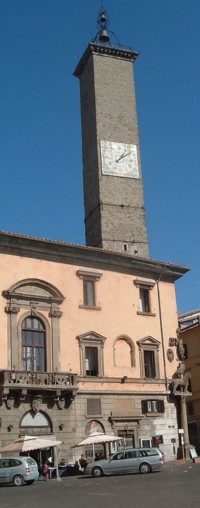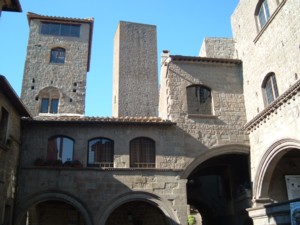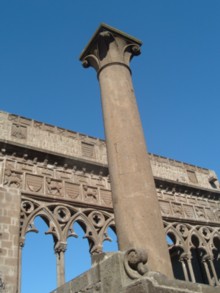Viterbo is in central Italy; a provincial capital located between the great tourist magnets of Rome and Tuscany. Although the town has enjoyed glory days, it’s now a quiet but interesting destination in a rural area rich with ancient Etruscan sites
Where is Viterbo?
Viterbo (population: 60,000) is in central Italy, around 65 miles (105km) north of Rome. The medieval walled hilltown is situated in the Lazio region, and is the administrative centre of its province, the Provincia di Viterbo. Rather confusingly, the area is also known as Tuscia, and lies within the loosely-defined area of Etruria, which spreads through Lazio, Umbria and Tuscany, incorporating the heartlands of the ancient Etruscan civilisation.

History
Various local finds suggests the site has ancient, though probably humble, origins. This area was the centre of the Etruscan civilisation, whose remains are dotted around the countryside, and a later Roman town was situated nearby at Ferento (Roman Ferentum). It was in the Middle Ages, however, in the twelfth and thirteenth centuries, that Viterbo attained real importance. While the city of Rome struggled through chaos and feuding, Viterbo became a favourite refuge for embattled popes. It may seem surprising now, but there was a time when Viterbo was larger and more successful than Rome, and much of its fine architecture, such as the Papal Palace, dates to this era. Later, the town faded in importance (its population today is approximately the same as it was then). Prior to the unification of Italy, Viterbo formed part of the Papal States. Now it sits quietly in an area usually overlooked by foreign tourists.
What to do in Viterbo
See the sights. The main attraction of Viterbo is the town’s medieval architecture: the remains of its grand Papal Palace (Palazzo dei Papi) and the humbler medieval lanes. Other individual sights of interest include a couple of museums, the town Cathedral and a selection of other palazzi and churches. Read more about things to see on our additional page: Viterbo tourist attractions.
Step back to the Middle Ages. Thanks to the town’s lack of development since its heyday in the Middle Ages, it is now famed for one of the best-preserved medieval centres in Italy, popular with film crews in search of authentic atmosphere. A pleasant half-hour can be spent wandering the medieval lanes of San Pellegrino, a historical area of unaltered stone houses with the original external staircases, little lanes, squares and towers. Viterbo is also a popular destination for antiques-hunters, with antiques fairs and little shops along the medieval lanes.
Visit thermal springs. Just outside Viterbo are the natural hot springs of Bullicame, known since ancient times. Nowadays there is a thermal spa complex on the site, called Terme dei Papi (Spa of the Popes). A range of treatments is offered, or you can pay a charge simply to use the facilities and bathe in the waters, which emerge at over 40 degrees (bring swimsuits and towels). An adventurous and atmospheric alternative, if you have a car, is to visit the hot sulphurous pools at Bagnaccio, which sit in the middle of the countryside. Drive along the Via Cassia Nord towards Montefiascone, and after about three miles take the turning towards Marta. A short way down this road take a left turning down a rough road by a Roman ruin. Along this unsurfaced road you’ll find the pools where you can bathe. Apparently these are maintained by volunteers and they are an unforgettable sight in the countryside: hot natural pools in a field where (on our visit) happy nearly-naked German tourists sat contentedly in steaming waters.
Events
Viterbo is famous for the trasporto della Macchina di Santa Rosa, a procession which takes place on the evening of 3rd September, to commemorate the relocation of the body of Saint Rosa from the Church of Santa Maria del Poggio to the church of San Damiano (the Sanctuary of Santa Rosa). The Macchina di Santa Rosa is a gigantic structure, nearly 30 metres high, which is carried through the streets by a large team of strong local men. Contests are held to select designs for the Macchina, which is replaced every five years. The porters who bear the Macchina are organised in an association, the Sodalizio dei Facchini di Santa Rosa, which has its own little museum.
Other town events include a May flower festival: San Pellegrino in fiore, and a Baroque festival taking place in September and October.
Food and drink
Visiting on a Monday outside the tourist season, we were rather limited for options. Our favourite discovery was the historic and truly grand Gran Caffè Schenardi on Corso Italia. The main salon is a spacious and elegant period piece, with a tempting array of cakes on offer (and classy bathrooms for the desperate tourist).A smaller room at the back offers a smart (but less gilded) dining experience where, despite the refined atmosphere, we paid a very reasonable 7.50 for a delicious plate of pasta with a mineral water.
The Tourist Information Office (and the guidebooks) recommend the busy little Tre Re on Via Macel Gattesco, close to Piazza del Plebiscito. Dotted around the historic centre are several restaurants and pizzerie, as well as small bars where visitors in a hurry can buy sandwiches. If you are selecting the picnic option, you can buy delicious (and affordable) pastries and ice cream at the Pasticceria Gelateria Catanese, Via Roma 19. Places to sit and rest include the sunlit steps of Piazza San Lorenzo while for picnics there is a green park below the historic centre (head downhill from Piazza del Plebiscito) and a park outside the Porta Fiorentina.
How to visit Viterbo
Viterbo makes a good excursion from Rome. The slow but interesting train ride gives visitors plenty of time to enjoy a day out from the capital – possibly with a side-trip to Bracciano thrown in.
For visitors who already know Italy’s tourist areas, who want an off-the-beaten-track experience, or who have a special interest in the area’s Etruscan history, Viterbo makes a good base for a longer stay. Hiring a car will facilitate sightseeing in this rural area, although there are also public transport options.

Around Viterbo
We would strongly recommend paying a visit to the Provincia di Viterbo tourist information office in Porta Romana station. At some point the local authority has obviously invested considerable time and effort trying to win tourists away from its rivals in Rome and Tuscany, for you will usually find a good stock of free booklets, pamphlets, maps and brochures here, many of them in English. This is a good place to start your exploration of this fascinating area. Around Viterbo you will find superb Etruscan archaeological sites, rolling green countryside, deep lakes, thermal spas and grand villas. You will find it much easier to explore the region by car, but if you are patient and research your options it is possible to visit most sites by public transport. Trains run to Bracciano and Rome, while a network of bus services connect the local towns and villages.
Bagnaia, just outside Viterbo, is a charming village dominated by the wonderful gardens of the Villa Lante. The attractive lakes of Northern Lazio are all in easy reach: Lakes Vico, Bolsena and Bracciano. Wine-lovers will enjoy a visit to Montefiascone, home of the white wine Est! Est!! Est!!!. The Umbrian towns of Spoleto and Orvieto are also within easy reach of Viterbo. On the Tuscan coast to the west lies Monte Argentario.
There is a superb Etruscan necropolis, famous for its wall-paintings, at Tarquinia, near the coast to the south-east of Viterbo, and another further south at Cerveteri. Smaller but fascinating Etruscan sites dot the area: for example at Sutri, Norchia and Vulci. The tourist information office has some good guides to the local Etruscan sites, and also publicises initiatives such as ‘A tavola con gli Etruschi’, an autumn celebration of traditional local products and cuisine.
How to get to Viterbo by public transport
There are a number of ways to get from Rome to Viterbo, none of them very fast. The simplest method is to take a commuter train from Rome’s Stazione Ostiense to Viterbo (from central Rome take Metro linea B to Piramide, then follow signs from the front of the Metro platform along passages to the main railway station). Trains are roughly hourly, and stop at Viterbo Porta Romana station, outside the Porta Romana (Roman Gateway) in the city walls. The journey takes nearly two hours, and costs 4.50 each way. Note that some services have a number of intermediate stops in Rome – check on the Trenitalia website as you may be able to shave time off your train journey.
Viterbo is also served by Cotral buses from Rome, which leave from the Saxa Rubra stop (on the urban railway from Flaminio). There are a couple of different routes, taking between between one and two hours. Cotral bus services also connect Viterbo with local towns and villages, and with Orvieto, Terni, Civitavecchia and Orte.
If you are hiring a car and heading straight to Viterbo, the nearest airport is Rome Fiumicino.
Viterbo accommodation
Viterbo does not buzz with tourist facilities, but it would make an atmospheric place to stay for a day or two. There is a decent choice of accommodation options in the town, ranging from good central B&Bs to large modern hotels by the thermal spas, some of which offer a range of ‘wellness’ packages. Tourists who are planning to hire a car may be interested in one of the area’s rural ‘agriturismo’ farmhouse stays.
> Viterbo hotels, B&Bs and apartments
Read more: Viterbo tourist attractions.
On this site
Useful external links
Lazio destinations
- About the Lazio region
- Anzio
- Bracciano
- Calcata
- Castel Gandolfo
- Castelli Romani
- Cerveteri
- Formia
- Frascati
- Gaeta
- Palestrina
- Pontine islands
- Ponza
- Rome
- Sperlonga
- Terracina
- Tivoli
- Ventotene
- Viterbo
